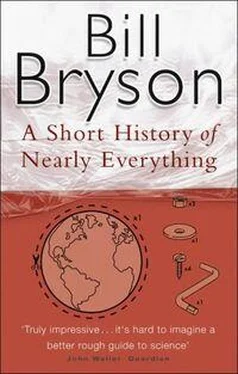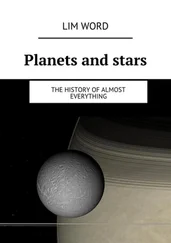“It was, truly, a mass extinction . . .” Fortey, Life , p. 235.
“Estimates for the number of animal species alive . . . ” Gould, Hen’s Teeth and Horse’s Toes , p. 340.
“For individuals the death toll could be much higher . . . ” Powell, Night Comes to the Cretaceous , p. 143.
“Grazing animals, including horses, were nearly wiped out . . .” Flannery, The Eternal Frontier , p. 100.
“At least two dozen potential culprits . . .” Earth , “The Mystery of Selective Extinctions,” October 1996, p. 12.
“tons of conjecture and very little evidence. . . .” New Scientist , “Meltdown,” August 7, 1999.
“Such an outburst is not easily imagined . . .” Powell, Night Comes to the Cretaceous , p. 19.
“The KT meteor had the additional advantage . . .” Flannery, The Eternal Frontier , p. 17.
“Why should these delicate creatures . . . ” Flannery, The Eternal Frontier , p. 43.
“In the seas it was much the same story.” Gould, Eight Little Piggies , p. 304.
“Somehow it does not seem satisfying . . . ” Fortey, Life , p. 292.
“could well be known as the Age of Turtles.” Flannery, The Eternal Frontier , p. 39.
“Evolution may abhor a vacuum . . .” Stanley, p. 92.
“For perhaps as many as ten million years . . . ” Novacek, Time Traveler , p. 112.
“guinea pigs the size of rhinos . . . ” Dawkins, The Blind Watchmaker , p. 102.
“a gigantic, flightless, carnivorous bird . . . ” Flannery, The Eternal Frontier , p. 138.
“built in 1903 in Pittsburgh . . .” Colbert, p. 164.
“came from only about three hundred specimens . . .” Powell, Night Comes to the Cretaceous , pp. 168-69.
“There is no reason to believe . . .” BBC Horizon , “Crater of Death,” first broadcast May 6, 2001.
“Humans are here today because . . .” Gould, Eight Little Piggies , p. 229.
CHAPTER 23 THE RICHNESS OF BEING
“The spirit room alone holds fifteen miles of shelving . . .” Thackray and Press, The Natural History Museum , p. 90.
“forty-four years after the expedition had concluded.” Thackray and Press, p. 74.
“still to be found on many library shelves . . .” Conard, How to Know the Mosses and Liverworts , p. 5.
“The tropics are where you find the variety . . .” Len Ellis interview, Natural History Museum, London, April 18, 2002.
“he sifted through a bale of fodder . . .” Barber, p. 17.
“To the parts of one species of clam . . .” Gould, Leonardo’s Mountain of Clams and the Diet of Worms , p. 79.
“Love comes even to the plants.” Quoted by Gjertsen, p. 237; and at University of California/UCMP Berkeley website.
“Linnaeus lopped it back to Physalis angulata . . .” Kastner, p. 31.
“The first edition of his great Systema Naturae . . .” Gjertsen, p. 223.
“John Ray’s three-volume Historia Generalis Plantarum . . .” Durant and Durant, p. 519.
“a kind of father figure to British naturalists.” Thomas, Man and the Natural World , p. 65.
“gullibly accepted from seamen and other imaginative travelers.” Schwartz, Sudden Origins , p. 59.
“he saw that whales belonged with cows . . .” Schwartz, p. 59.
“mare’s fart, naked ladies, twitch-ballock . . .” Thomas, pp. 82-85.
. . . “Edward O. Wilson in The Diversity of Life . . .” Wilson, The Diversity of Life , p. 157.
“transferred, amid howls, to the genus Pelargonium .” Elliott, The Potting-Shed Papers , p. 18
“Estimates range from 3 million to 200 million.” Audubon, “Earth’s Catalogue,” January-February 2002, and Wilson, The Diversity of Life , p. 132.
“as much as 97 percent . . .” Economist , “A Golden Age of Discovery,” December 23, 1996, p. 56.
“he estimated the number of known species of all types . . .” Wilson, The Diversity of Life , p. 133.
“Other authorities have put the number . . .” U.S. News and World Report , August 18, 1997, p. 78.
“It took Groves four decades to untangle everything . . .” New Scientist , “Monkey Puzzle,” October 6, 2001, p. 54.
“about fifteen thousand new species of all types . . .” Wall Street Journal , “Taxonomists Unite to Catalog Every Species, Big and Small,” January 22, 2001.
“It’s not a biodiversity crisis, it’s a taxonomist crisis!” Ken Maes, interview with author, National Museum, Nairobi, October 2, 2002.
“many species are being described poorly . . .” Nature , “Challenges for Taxonomy,” May 2, 2002, p. 17.
“an enterprise called the All Species Foundation . . .” The Times (London), “The List of Life on Earth,” July 30, 2001.
“your mattress is home to perhaps two million microscopic mites . . .” Bodanis, The Secret House , p. 16.
“to quote the man who did the measuring . . .” New Scientist , “Bugs Bite Back,” February 17, 2001, p. 48.
“These mites have been with us since time immemorial . . .” Bodanis, The Secret House , p. 15.
“Your sample will also contain perhaps a million plump yeasts . . .” National Geographic , “Bacteria,” August 1993, p. 39.
“If over 9,000 microbial types exist . . .” Wilson, The Diversity of Life , p. 144.
“it could be as high as 400 million.” Tudge, The Variety of Life , p. 8.
“discovered a thousand new species of flowering plant . . .” Wilson, The Diversity of Life , p. 197.
“tropical rain forests cover only about 6 percent . . .” Wilson, The Diversity of Life , p. 197.
“over three and a half billion years of evolution.” Economist , “Biotech’s Secret Garden,” May 30, 1998, p. 75.
“found on the wall of a country pub . . .” Fortey, Life , p. 75.
“about 500 species have been identified . . .” Ridley, The Red Queen , p. 54.
“all the fungi found in a typical acre of meadow . . .” Attenborough, The Private Life of Plants , p. 176.
“the number could be as high as 1.8 million.” National Geographic , “Fungi,” August 2000, p. 60; and Leakey and Lewin, The Sixth Extinction , p. 117.
“The large flightless New Zealand bird . . .” Flannery and Schouten, A Gap in Nature , p. 2.
“was considered a rarity in the wider world.” New York Times , “A Stone-Age Horse Still Roams a Tibetan Plateau,” November 12, 1995.
“a sort of giant ground sloth . . .” Economist , “A World to Explore,” December 23, 1995, p. 95.
“A single line of text in a Crampton table . . .” Gould, Eight Little Piggies, pp. 32-34.
“he hiked 2,500 miles to assemble a collection . . .” Gould, The Flamingo’s Smile , pp. 159-60.
Читать дальше












